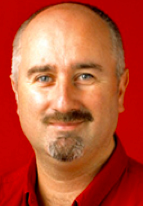Co-Located Conference AgendasHigh-Content and Phenotypic Screening Europe 2018 | Stem Cells and Antibodies in Drug Discovery Europe 2018 | 

Thursday, 24 May 201808:00 | Conference Registration, Materials Pick-Up, Morning Coffee, Tea and Breakfast Pastries | |
Session Title: Conference Opening Session Framing the Key Topics and Opportunities in these Fields |
| | 09:00 |  | Keynote Presentation Partnering in the Discovery & Development of Novel Biotherapeutics: A Perspective from Cancer Research UK
Robert Williams, Chief Drug Development Scientist, Cancer Research UK, United Kingdom
Cancer Research UK is the world’s largest charitable funder of cancer
research. The organization has a long history of supporting the
discovery and development of novel anti-cancer medicines. CRUK works
extensively with academic institutes, biotechnology and pharmaceutical
companies utilising a wide range of partnering arrangements and business
frameworks. This presentation will describe examples of innovative
collaborations in the discovery and development of new antibody-based
therapeutics. |
| 09:45 | .png) | Keynote Presentation Stem Cell Derived Cardiomyocytes in Drug Discovery and Development: What We’ve Learned, and What We Are Going to Learn
Gary Gintant, Senior Research Fellow, Abbvie, United States of America
After nearly a decade of studies, we have learned much about human induced pluripotent stem-cell derived cardiomyocytes. This presentation will discuss various key findings with these evolving preparations as related to cardiac safety and drug discovery, citing new initiatives and challenges for continuing progress from pharmaceutical and regulatory perspectives over the next decade. |
| 10:30 | Morning Coffee and Tea Break and Networking | 11:00 |  | Keynote Presentation iPSC-based Models of Heart Disease – How to Make Them and Study Them Properly
Matthew Daniels, Wellcome Trust Intermediate Clinical Fellow, Honorary Consultant Cardiologist, University of Oxford, United Kingdom
Many iPSc based models of inherited heart disease are now available, but
very little has been done to improve the way they are analyzed. I will
demonstrate an example of iPS to validate a whole genome sequencing
result, and show how various contemporary phenotyping strategies fail
but can be improved. |
| 11:45 |  HTRF Assays + Reagents for Biologics Drug Discovery HTRF Assays + Reagents for Biologics Drug Discovery
Louise Affleck, UK Team Leader, Cisbio Bioassays
The HTRF assay platform is robust and flexible and can be applied to a
large range of drug targets for small and large molecule drug research.
This presentation highlights PPI assays, ADCC binding assays, IgG
quantification assays.
| 12:15 | Networking Lunch -- Meet the Exhibitors and View Posters | |
Session Title: Stem Cells for Drug Discovery - Current Status |
| | 13:30 |  iPSC-Based Physiologically Relevant Disease Modeling for CNS Drug Discovery and Neurotoxicity Screening iPSC-Based Physiologically Relevant Disease Modeling for CNS Drug Discovery and Neurotoxicity Screening
Jason Lo, Account Manager (EU + UK), Applied StemCell, Inc.
An iPSC-based approach to modeling human diseases provides an unlimited source of physiologically relevant in vitro tools for basic and applied research, with potential applications in personalized regenerative medicine. Unlike primary cells, iPSCs are amenable to CRISPR/Cas9 genome editing, thereby enabling the generation of numerous cell line models for hard-to-source and hard-to-model diseases, especially neurological disorders. Further differentiation of these genome edited iPSCs and their isogenic matched controls (parental line) into somatic lineages provides a controlled in vitro platform to investigate disease phenotypes, and for drug discovery and screening. This talk elaborates on the workflow involved in generating biorelevant iPSC models of neurological disorders such as Parkinson’s Disease, its differentiation into neural lineages, and suitability as a preclinical platform for screening potential drug candidates for efficacy and neurotoxicity, including assays to determine the specificity of different neural cell types for a small range of chemicals and drugs from the Tox21 library, as well as for neuroprotective assays with dopaminergic neurons.
| 14:00 | Human Stem Cell Research for Potential Drug-induced Cardiac and Neuronal Side Effects
Hua Rong Lu, Senior Principal Scientist, Discovery Sciences, Janssen Pharmaceutical NV, Belgium
Human induced pluripotent stem cell-derived cardiomyocytes (hiPS-CMs)
and HiPS-neurons are increasingly used as a new source of human
based-cells for drug safety assessment. Indeed attention to this field
may increase in response to the FDA’s CiPA proposal for long QT and
pro-arrhythmias and HESI-MEA for drug-induced seizures. Within Janssen,
we are currently investigating the effects of different reference
compounds in different types of hiPS-CMs and hiPS-neurons using
different high content screen assays, and establishing potential assay
(s) using HiPS-cells for early drug discovery and development. | 14:30 | Human Stem Cell-Derived Renal Cells and High-Throughput Nephrotoxicity Prediction
Jacqueline Chuah, Lab Officer, Institute of Bioengineering and Nanotechnology, A*Star, Singapore
The kidney is a major target for compound-induced toxicity. Animal-free alternative methods are required by governmental agencies and various industries to decrease costs and increase the throughput of nephrotoxicity prediction. We have developed the first accurate and pre-validated in vitro models for predicting compound-induced nephrotoxicity in humans (Loo and Zink, 2017; Chuah and Zink, 2017; Kandasamy et al., 2015; Li et al., 2014; Li et al., 2013; Su et al., 2014; Su et al., 2016). Our models include the first and only pre-validated and predictive stem cell-based renal in vitro models (Li et al., 2014; Kandasamy et al., 2015; Chuah and Zink, 2017). The most advanced of these models is based on induced pluripotent stem cell (iPS)-derived renal proximal tubular (PTC)-like cells. A rapid one-step protocol has been established for the generation of PTC-like cells in 8 days of differentiation, and these cells can be directly used for compound screening (Kandasamy et al., 2015). Alternatively, PTC-like cells can be applied after cryopreservation. By combining iPS-derived renal cell-based assays with machine learning methods, a test balanced accuracy of 87% could be achieved with respect to nephrotoxicity prediction (Kandasamy et al., 2015; Chuah and Zink, 2017). In addition, underlying mechanisms of drug-induced cellular injury could be correctly identified. We have also established a high-content screening (HCS) platform that combines high-content imaging of renal cells with automated phenotypic profiling and machine learning methods (Su et al., 2016). The automated HCS platform has a test balanced accuracy ranging between 82%-89%, depending on the human renal cell type used (Su et al., 2016; Loo and Zink, 2017). Based on these technologies we are currently developing a portfolio of platforms for the prediction of compound-induced toxicity to various organs. In addition, a kidney-on-chip platform for repeated dose testing is under development. This platform appears to be suitable for the assessment of the human dose response. | 15:00 | Applications of Human Pluripotent Stem Cells for Neuromuscular Diseases: Advances and Challenges
Masatoshi Suzuki, Associate Professor, Department of Comparative Biosciences and Stem Cell & Regenerative Medicine Center, University of Wisconsin-Madison, United States of America
Neuromuscular diseases are caused by functional defects of skeletal
muscles directly via muscle pathology or indirectly via the nervous
system. Extensive studies have been performed to improve the outcomes of
therapies; however, effective treatment strategies have not been fully
established in any major neuromuscular disease. Human pluripotent stem
cells, such as embryonic stem cells and induced pluripotent stem cells,
have a great capacity to differentiate into skeletal muscle
progenitor/stem cells (or called myogenic progenitors) and skeletal
myocytes for use in treating and modeling neuromuscular diseases.
Particularly, recent advances allow us to create patient-derived stem
cells, which can be used as a unique platform for comprehensive study of
disease mechanisms and drug screening in vitro. In the last decade, a
number of protocols (including ours) have been established for
derivation of skeletal muscle cells from human pluripotent stem cells.
These protocols have been developed by following the process of
myogenesis controlled by the expression of transcription factors and
signaling molecules to specify cellular lineage during muscle
development. This presentation overviews recent progress of the
protocols for skeletal muscle derivation using human pluripotent stem
cells. We also discuss the potential limitations and promise of these
approaches for future applications of myogenic progenitors and myocytes
in neuromuscular diseases. | 15:30 | Afternoon Coffee and Tea Break and Networking | 16:00 | Bridging the Translational Gap: A hiPSC Model of Marfan Syndrome for Drug Discovery
Sanjay Sinha, BHF Senior Research Fellow, University of Cambridge, United Kingdom
Marfan syndrome is a connective tissue disorder, caused by mutations in
FBN1, with pleiotropic manifestations including aortic aneurysms and
dissection. Although the angiotensin II receptor blocker, losartan, was
effective in treating the disease in mouse models, clinical trials have
been much less successful. In this presentation, I will discuss the use
of a hiPSC model of aortic disease in Marfan syndrome to understand the
molecular basis of this disease and why the mouse studies may not have
translated well to patients. I will also describe how this complex in
vitro system can be used for novel drug screening for this devastating
clinical disorder. | 16:30 | Modeling Endoderm Development and Disease Using Human Stem Cells
Nicholas Hannan, Assistant Professor, University of Nottingham, United Kingdom
| 17:00 |  Get Ready to LEAP: Advances in Automated Arrhythmia Detection for Next-Generation hiPSC-CM MEA Assays Get Ready to LEAP: Advances in Automated Arrhythmia Detection for Next-Generation hiPSC-CM MEA Assays
Giovanna Defilippi, Sr. Field Applications Scientist, Axion BioSystems
Trends in cardiac safety testing, as exemplified by CiPA and JiCSA, emphasize a move beyond surrogate measures of proarrhythmia. The cardiomyocyte and multiwell microelectrode array (CM-MEA) assay offers an ideal approach to evaluate pre-arrhythmic indicators in vitro. Join Axion BioSystems to discuss the new Local Extracellular Action Potential (LEAP) for next-generation CM-MEA assays. The LEAP assay allows you to record extracellular action potential waveforms and characterize repolarization irregularities (e.g. EADs), label-free and in real-time.
| 17:30 |  | Keynote Presentation Automated Hepatocyte Differentiation From Pluripotent Stem Cells and Their Use in Drug Screening
David Hay, Chair of Tissue Engineering, MRC Centre for Regenerative Medicine, University of Edinburgh, United Kingdom
In both preclinical and clinical testing, drug induced liver injury
(DILI) is the major cause of drug attrition, costing pharmaceutical
companies millions of dollars every year (Ware & Kehtani 2017,
Trends in Biotechnology). It is therefore essential to rapidly identify
and remove drug candidates that pose a risk, decreasing development
costs and improving post market success. Currently primary human
hepatocytes (PHH) are the most widely used cell type for the prediction
of DILI. However when cultured in vitro PHH do not proliferate, rapidly
lose their phenotype, in particular drug metabolism. Furthermore,
sources are limited and usually isolated from diseased tissue limiting
their utility in large scale drug screening. The cost effective delivery
of human tissue from a renewable resource, such as pluripotent stem
cells (PSCs), offers a possible solution to the issues associated with
human somatic cells for in vitro testing. Of note, PSC derived
hepatocytes have previously been shown to be as sensitive and
predictable as the pharmaceutical ‘gold standard’ PHH (Szkolnicka et al
2014, Stem Cells Translational Medicine and Szkolnicka et al 2016, Stem
Cells Translational Medicine). More recently, improvements in culture
methods and protocols have led to further improvement in hepatocyte
function and stability. The focus of our recent research has been to
combine defined differentiation with automation to deliver reliable and
stable liver models at scale. In order to multiplex our cell based
screening tool we have used a cytological assay that ‘paints the cell’,
specifically marking intracellular components of the cell, allowing high
through put and multi-parametric analysis (Gustafsdottir et al 2013,
PLoS One; Bray et al 2016, Nature Protocols). PSCs were differentiated
into hepatocyte like cells (HLCs) using a previously published protocol
(Cameron et al 2015, Stem Cell Reports). Once mature HLCs were incubated
with a pharmaceutical grade compound library provided by AstraZeneca.
Following 48 hours exposure, we scored for drug toxicity, using multiple
endpoints and correctly identified drug toxicity in compounds tested.
In conclusion, we have developed an automated, reproducible, and
scalable platform to generate functional hepatocytes for human drug
screening. Importantly, the production method is GLP compliant and cost
effective (Cameron et al 2015, Stem Cell Reports). Going forward our
automated system will be further miniaturised and fine-tuned to study
genetic variation in the human population. |
| 18:15 | Networking Reception with Beer and Wine. Engage and Network with Your Colleagues, and Connect with the Exhibitors | 19:15 | Close of Day 1 of the Conference |
Friday, 25 May 201807:30 | Morning Coffee, Tea, Breakfast Pastries and Networking | |
Session Title: High Content and Phenotypic Screening |
| | 08:00 | High-Content Screening for Adverse Cytologic Effects
Peter O'Brien, Head of Clinical Pathology, University College Dublin, Ireland
The first, highly-effective, high-content-screening (HCS) for adverse cytologic effect was reported a decase ago (Arch Toxicol 2006, 80, 580). Success was attributed to simultaneous measurement of multiple “cytobiomarkers”, use of human cells that can metabolise drugs, 72 h exposure for slow toxicants, exposure to wide-ranging concentrations, and normalizing toxic to efficacious concentration. Many HCS studies now support this approach as necessary in predictive toxicology, as does review of literature since the ?rst cytotoxicity assay was reported 100 years ago. A subset of the original toxicants was reanalyzed using the original HCS confirming high sensitivity and speci?city across locations, technologies, sta?, laboratories, and time. A protocol is demonstrated for operational validation of the HCS within labs to document pro?ciency and quality management. | 08:30 | Using Patient-Specific Induced Pluripotent Stem Cells to Model Retinal Diseases
Alice Pébay, Associate Professor, Principal Research Fellow, University of Melbourne & Centre for Eye Research Australia, Australia
Maciej Daniszewski, Researcher, University of Melbourne, Australia
Age-related macular degeneration (AMD), primary open-angle glaucoma (POAG) are leading ageing neurodegenerative diseases of the eye. Although phenotypically distinct, their respective pathophysiologies do share similarities. They are chronic, progressive, and lead to the degeneration of neurons key to the function of the retina or optic nerve. If no treatment is found, the direct and indirect costs associated with these conditions will drastically increase. But Despite enormous research efforts, treatment options are still limited, with no current definitive treatment for AMD and POAG. This paucity of treatment options can be attributed to a fundamental absence in the knowledge around what causes these conditions and how they progress. We use of patient-specific induced pluripotent stem cells (iPSCs) to obtain the key cells involved in these diseases. To increase power of analysis, we use automation of cell culture to allow large-scale modelling of AMD and POAG. Those methods will be discussed. Ultimately, we aim to improve our molecular understanding of those neurodegenerative diseases, and ultimately facilitate preclinical trials, and translatable outcomes. | 09:00 |  More Content from High-Content Screening: Analyzing Specimen in 3D More Content from High-Content Screening: Analyzing Specimen in 3D
Alexander Schreiner, Team Leader Biological Applications, PerkinElmer
When developing a screening assay one of the most critical aspects is the choice of cellular model including the decision to choose between 2D or 3D approaches. Multicellular “oids” (tumoroids, spheroids, organoids) bear the potential to better predict drug candidate effects during preclinical screening. However, 3D models require more effort and compared to 2D cultures, 3-dimensional assays tend to be more complex across all steps of the workflow. Reliably generating sufficiently large numbers of uniform spheroids for screening and imaging of 3D volumes at high quality are among the challenges. Using 3D spheroids and cysts as examples, we will show experimental workflows, explaining how to effectively grow these models using ULA coated U-bottom plates or low concentration gels. The careful selection of dyes and clearing strategies can improve the image quality while targeted imaging of spheroids helps to significantly shorten imaging times and to minimize the data volume. Nevertheless, being able to effectively analyze spheroids is still one of the main bottlenecks. Dedicated high-content software tools can help users to, speed up 3D image acquisition by targeted imaging of objects of interest, better understand the spatial context of your 3D cell models through different visualization methods, measure volume and morphology changes in 3D to characterize your specimen in detail and export 3D movies to share and publish your results.
| 09:30 | Exploring in vitro Vibrational Microspectroscopy for High Content Analysis
Hugh Byrne, Professor, Dublin Institute of Technology, Ireland
The potential of vibrational spectroscopy, but infrared absorption and Raman scattering, in the fields of biological and biomedical applications has been well demonstrated. The techniques provide molecular based profiles of the biomolecular content, in a label free, non-destructive manner, which, in the microscopic mode, can have subcellular resolution. Multivariate statistical analysis is commonly employed to extract high content information concerning cellular metabolism and response pathways. The presentation provides an over view of efforts to advance the application of vibrational spectroscopy for high content cellular analysis, using examples of exposure to model nanoparticles and chemotherapeutic agents. This progress is discussed in the light of emerging technologies in the field of spectroscopic microscopy. | 10:00 | Coffee Break and Networking | 10:30 | Collaborative Phenotyping at King’s: HipSci and the Stem Cell Hotel
Davide Danovi, Director, Cell Phenotyping Platform, Kings College London, United Kingdom
We work in the framework of the Human Induced Pluripotent Stem Cells Initiative (HipSci) project, funded by the Wellcome Trust and MRC. We provide a dedicated laboratory space for collaborative cell phenotyping to study how intrinsic and extrinsic signals impact on human cells to develop assays for disease modeling and drug discovery and to identify new disease mechanisms. | 11:00 |  High-Content Screening of Complex Biological Models High-Content Screening of Complex Biological Models
Ben Haworth, Cellular Imaging Application Specialist, GE Life Sciences
Exploring how the IN Cell Analyzer Platforms delivers image quality and
speed in high-content Analysis workflows. We will look at how the
systems can be used to optimize assays using both 3D and live models.
| 11:30 |  Enabling Early Stage Muscle Drug Discovery with MyoScreen™, a High-throughput High-content Phenotypic Screening Platform Deploying Micropatterned Human Primary Skeletal Myotubes Enabling Early Stage Muscle Drug Discovery with MyoScreen™, a High-throughput High-content Phenotypic Screening Platform Deploying Micropatterned Human Primary Skeletal Myotubes
Joanne Young, Senior Scientist, CYTOO SA
CYTOO has recently developed a disease relevant phenotypic muscle drug discovery platform to fully leverage the characterization of compounds at an early stage of the drug discovery pipeline. MyoScreen™ deploys imaging and image-analysis methodology along with a micropatterned plate system that allows the precise control of myotube length and the formation of highly aligned myotubes.
In this seminar, I will discuss the robust performance of the MyoScreen™ platform and show how it exploits the improved architecture and maturity of micropatterned myotubes, which are superior to standard 2D culture, to quantitatively analyze drug effects on proliferation, hypertrophy/atrophy, acetylcholine receptors, as well as providing a screening index of contractile force. I will also describe actual use of MyoScreen™ in a primary screen with secondary hit validation, focusing on two intriguing hits that were identified to enhance myotube function by distinct mechanisms of action.
| 12:00 |  | Keynote Presentation Multidimensional Fluorescence Imaging For High Content Analysis and Preclinical Applications
Paul French, Professor, Department of Physics and Photonics Group, Imperial College London, United Kingdom
We are developing multidimensional fluorescence imaging technology with a particular emphasis on fluorescence lifetime imaging (FLIM) across the scales to contrast different molecular species and to map variations in the local fluorophore molecular environment, particularly due to Forster resonant energy transfer (FRET) in order to assay protein interactions or read out genetically expressed FRET biosensors. For high content analysis (HCA) we are implementing automated time-gated FLIM for multiwell plate assays of protein interactions or cellular metabolism. We have applied FLIM FRET HCA to study signalling and disease mechanisms in 2-D and 3-D cell-based assays, including the intracellular measurement of KD to quantify protein interactions. For in vivo preclinical studies, we are combining optical projection tomography (OPT) with FLIM, particularly applied to live zebrafish - from larvae up to adults - and are developing FLIM endoscopy to read out FRET biosensors in murine disease models. We aim to implement our multidimensional fluorescence imaging technology using open source software tools for instrument control, data acquisition, analysis and management and to provide lists of equipment components to enable other users to replicate our instrumentation for application to their own biological questions. Our open source FLIM analysis software, FLIMfit which provides rapid global fitting capabilities and is available as an OMERO client and our FLIM HCA and OPT instrumentation are controlled by µManager. |
| 12:30 | Robust & Efficient Tools for Pluripotent Stem Cell Research
Wing Chang, R&D Director, STEMCELL Technologies, United Kingdom
| 13:00 | Networking Lunch -- Meet the Exhibitors and View Posters | |
Session Title: Antibodies in Drug Discovery and Emerging Areas |
| | 13:30 | Nanobodies Against Influenza and Their Applications in Preparing For Future Pandemics
Simon Hufton, Section Head Molecular Immunology, National Institute for Biological Standard and Control (NIBSC), United Kingdom
Both seasonal and pandemic influenza continue to represent a formidable
public health challenge. The constant evolution of new strains means the
rapid availability of highly specific neutralising monoclonal
antibodies are of considerable interest. Nanobodies are emerging as next
generation antibodies with a number of well documented advantages which
make them highly amenable to applications in the infectious disease
area. This presentation will describe the isolation and characterization
of nanobodies specific for key influenza subtypes including ‘swine flu’
A(H1N1), highly pathogenic avian influenza A(H5N1), highly pathogenic
avian influenza A(H7N9), A(H3N2) and B lineage influenza viruses. The
use of yeast display for mapping their epitopes on hemagglutinin will
also be presented as will their potential applications in preparing for
future influenza pandemics. | 14:00 | Exploiting the Multiple Functions of FcRn for Therapy
E. Sally Ward, Professor, Texas A&M University Health Science Center, United States of America
The central role of FcRn in regulating IgG persistence and transport
provides opportunities for targeting this receptor in multiple different
diagnostic and therapeutic situations. The engineering of IgGs with
higher affinity for FcRn can be used to produce antibodies with longer
in vivo half-lives, but only if the pH dependence of the IgG-FcRn
interaction is retained. Conversely, engineered IgGs with increased
affinity for FcRn at both acidic and near neutral pH act as potent
inhibitors of FcRn. Consequently, such antibodies (‘Abdegs’, for
antibodies that enhance IgG degradation) can lower the levels of
endogenous IgG. Recent studies in our laboratory have also resulted in
the generation of engineered Fc-fusions that selectively clear
antigen-specific antibodies (‘Seldegs’, for selective degradation).
Recent developments related to the modulation of IgG dynamics will be
presented. We have demonstrated that the loss of expression of FcRn in
tumor cells results in increased intracellular albumin accumulation and
tumor growth in mouse models. These observations have implications for
tumor immunotherapy and indicate a novel function for FcRn as a
metabolic regulator. | 14:30 |  | Keynote Presentation New Ways For Human Antibodies - From Intracellular Applications to Switchable Affinity
Stefan Dubel, Full Professor and Director, Technische Universität Braunschweig, Germany
While the generation and optimization of human antibodies by phage display today allows to design fine specificity and kinetic parameters in detail, and CAR-T-cells, ADCs, bi-specific antibodies and many others creative derivatives of the original IgG molecule are approved or in clinical studies, the antibody molecule still offers many opportunities for new and innovative applications. The access of intracellular antigens with biologicals would add a huge target space to therapeutic antibodies. We used intra-bodies in the first protein knock down mouse to demonstrate the in vivo function of this principle, but also analysed many strategies to insert antibodies from the outside of the cell. On another end, using cyclic mutants of human calmodulin as an allosteric effector module, antigen binding affinity of different antibodies could be regulated. This allosteric effect was demonstrated for five different scFv fragments under physiological conditions on living cells without the need of pH or ion concentration changes. |
| 15:15 |  | Keynote Presentation Yeast as a Compound-Target Pair Discovery Tool
Stephen Helliwell, Senior Investigator, Novartis Institutes for BioMedical Research, Switzerland
I will briefly summarize our efforts at Novartis to identify yeast bioactive LMWs and identify their targets using uHTS screens and chemogenomic profiling – known as HIP HOP. |
| 16:00 | Overcoming Antigen-Mediated Antibody Clearance
Tristan Vaughan, Vice President, R&D, Antibody Discovery and Protein Engineering, MedImmune Ltd, United Kingdom
An antigen can act as a “sink” for antibody clearance if the antibody binds to an antigen which is rapidly eliminated. High levels of antibody clearance can impede and often halt the development of a novel therapeutic due to an impossibly large dose that would be required to overcome the sink for the drug to bring any patient benefit. Here, an antibody engineering solution to rapid clearance will be described and a case study presented.
| 16:30 | Enhanced Interrogation of the B Cell Repertoire For Antibody Discovery
Win-Yan Chan, Research Scientist, UCB, United Kingdom
An overview of the automated, high through-put antibody discovery platform at UCB and our single-cell recovery technology for antibody discovery. Using a sophisticated screening cascade at an early stage of antibody discovery, we are able to find high quality antibodies that will go on to make the best therapeutic candidates. | 17:00 | Close of Day 2 of the Conference |
|


 Add to Calendar ▼2018-05-24 00:00:002018-05-25 00:00:00Europe/LondonHigh-Content and Phenotypic Screening Europe 2018High-Content and Phenotypic Screening Europe 2018 in Cambridge, UKCambridge, UKSELECTBIOenquiries@selectbiosciences.com
Add to Calendar ▼2018-05-24 00:00:002018-05-25 00:00:00Europe/LondonHigh-Content and Phenotypic Screening Europe 2018High-Content and Phenotypic Screening Europe 2018 in Cambridge, UKCambridge, UKSELECTBIOenquiries@selectbiosciences.com